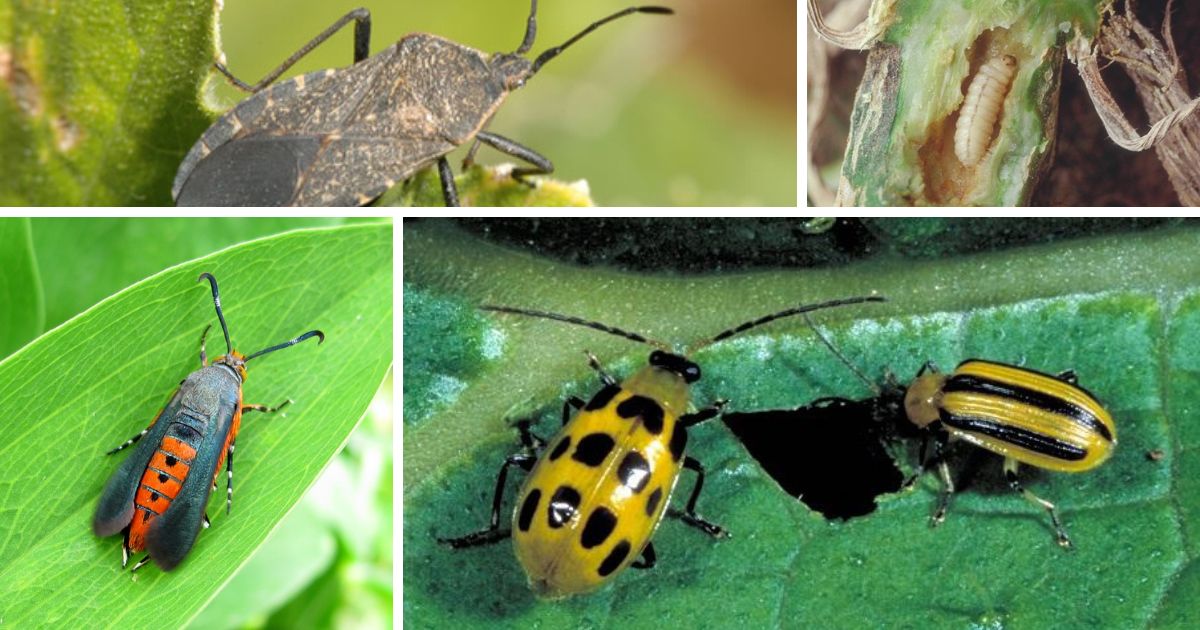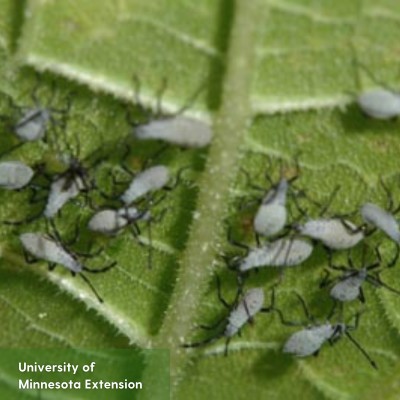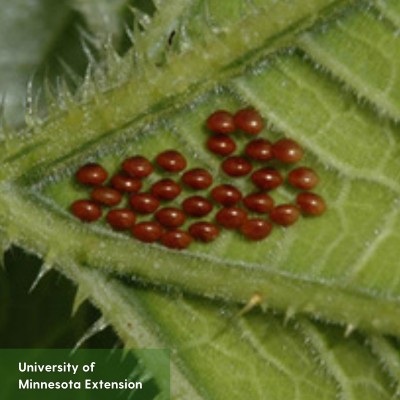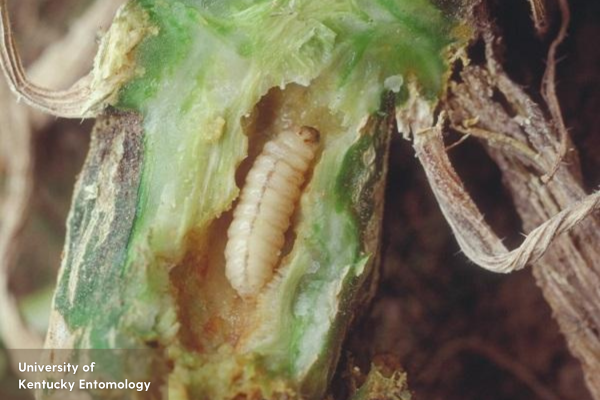
Fact Sheets And Publications

Non-chemical pest control options for managing insect pests on Cucurbits
(Squash, pumpkin, melons, cucumbers)
Reviewed in March 2025 | Written by: Dr. Judy Hough-Goldstein, Master Gardener
July and August in the vegetable garden typically bring bountiful harvests of colorful vegetables. These are also the months when insect pests can really make their presence known, with plant and fruit damage becoming increasingly noticeable.
Jump to: Cucumber beetles | Squash bugs | Squash beetles | Squash vine borer

Cucumber Beetles (spotted and striped)
Crops attacked
Cucumber, squash, and other cucurbits.
Type of damage
Adults feed on leaves, flowers, and fruits of cucumber, squash, and other cucurbits (spotted cucumber beetles also feed on other plant species). Both striped and spotted cucumber beetles can transmit bacterial wilt disease, which can cause sudden wilting and death of plants.
Life cycle and Suggested non-chemical control methods
- Unmated adults of both species overwinter in debris; adults emerge when soil temperatures reach ~55 °F, feed on pollen and on other plants until cucurbits become available. They mate on host plants, then lay eggs at the base of plants, under the soil. Larvae feed on roots (but cause little damage) and pupate in the soil.
- Males produce an aggregation pheromone, and adults are also attracted by cucurbitacins (which act as feeding stimulants and defenses once ingested) and by the color yellow.
- For both species, remove crop debris in the fall to reduce overwintering sites.
- Late planting (after June 15) may avoid adults that have already emerged and dispersed.
- Handpicking is difficult because adults are fast and drop when disturbed; however, you may be able to kill dropping beetles by placing a container of soapy water under them.
- Rotate crops as much as possible.
- Commercial or homemade yellow sticky traps, with or without chemical attractants, can kill adult beetles.

Squash bug
Crops attacked
All cucurbits, especially squash and pumpkin.
Type of damage
Both nymphs and adults suck plant sap. It may cause small plants/seedlings to wilt and die; little damage occurs to older plants in midsummer and fall.
Life cycle and Suggested non-chemical control methods
- Squash bugs overwinter as adults, becoming active around June. They are secretive, hiding on plants or in mulch. Numerous egg clusters are laid, usually on leaf undersides. Eggs are bronze-orange, oval. Typically have one generation, but two may occur.
- Row covers can prevent egg laying; however, plants may be colonized when covers are removed (necessary when plants bloom for pollination).
- Can delay planting squash until the early months of summer to avoid overwintered adult squash bugs seeking host plants.
- Egg clusters are difficult to crush; you may need to tear out a small piece of leaf.
- Nymphs are very gregarious and usually feed on the undersides of plants.
- Use a piece of duct tape wrapped around fingers (sticky side out) to trap nymphs; flick them into soapy water; or use a finger gripper (for handling paper) to squash and remove eggs and nymphs.
- Adults can be found congregating on plant stems at the soil level.
- Place boards on soil near the plant; check for congregating adults and nymphs, and destroy in the morning (crush between two hard surfaces).
- Remove plant debris during the season to reduce hiding places and in fall to reduce overwintering sites.
- Practice crop rotation to reduce spring infestations.



Squash Beetles
Squash beetles are in the same genus as the Mexican bean beetle, and their larvae look very similar. The adults of squash beetles are also similar to Mexican bean beetle adults but about twice as large—and they feed on squash, not beans!
Crops attacked
All cucurbits, especially squash.
Type of damage
Both larvae and adults eat leaves.
Life cycle and Suggested non-chemical control methods
- Adults overwinter, move to cucurbits in June and lay eggs in July. Larvae grow for about four weeks, then pupate on the underside of cucurbit leaves. The next generation of adults emerge in August and feed until September, when they leave the garden and seek shelter for the winter.
- Eliminate adults as soon as possible, using the same technique as for Mexican bean beetle adults.
- Crush or remove any eggs and larvae
- Note that populations of squash beetles are usually quite small, so in a small squash patch, manual control should be enough for control.

Squash vine borer
Crops attacked
Summer squash, winter squash, and pumpkins.
Type of damage
Larvae feed inside stems; once they get large enough to block water transport, entire stems or plants may suddenly wilt.
Life cycle with suggested control methods
Full-grown larvae or pupae overwinter in the soil. The colorful day-flying moths emerge in early summer and lay eggs singly on stems near the base of susceptible plants (up to 150 eggs per month!)
- Adult moths may be seen resting on leaves. Flick them into a container of soapy water to drown them.
Small brown eggs hatch in 1 – 2 weeks, and larvae quickly bore into stems, where they feed internally for 4 – 6 weeks. Sawdust-like frass and entry holes may be seen at the base of plants.
- If you suspect an infestation, you can use a garden syringe to inject the bacterial insecticide Bt (Bacillus thuringiensis) into the base of the stems. Larvae that ingest Bt will die. It can also be sprayed on stems as a preventive, killing newly hatched larvae before they bore into the stems.
- You can physically remove larvae from the stem. Follow the frass to the borer hole. With a sharp knife, carefully slit the vine lengthwise, and remove and destroy the borer. Check closely for multiple borers. Immediately cover the slit stem with soil to encourage rooting and healing.
- Mulch or bury the squash plant’s nodes as stems lengthen to encourage rooting, which may limit damage from larval boring.

This factsheet was created for UD Cooperative Extension and the Delaware Master Gardener Program by Dr. Judy Hough-Goldstein.
UD Cooperative Extension
This institution is an equal opportunity provider.
In accordance with Federal law and U.S. Department of Agriculture policy, Cooperative Extension is prohibited from discriminating on the basis of race, color, national origin, sex, age, or disability.
